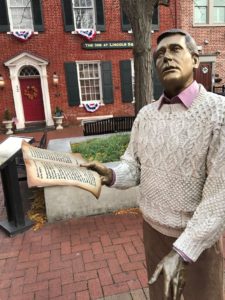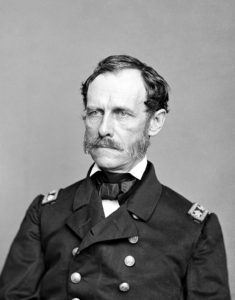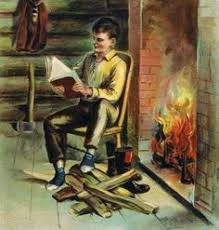 Last year I started off my annual science traveling post with “Well, this shouldn’t take long.” Despite expectations, I could have started my 2021 post with: “Ditto.”
Last year I started off my annual science traveling post with “Well, this shouldn’t take long.” Despite expectations, I could have started my 2021 post with: “Ditto.”
My year in traveling looks like my previous year’s “goals” list; just change the date and carry over everything to this year. Now I’ll be carrying most of it over to 2022. As with everyone else, I’ve grown exhausted by the continuing battle with COVID, in part due to its evolving variants, and in part due to the irresponsible choices of many to remain unvaccinated. And as with everyone else, it has crimped my traveling schedule. Luckily, I was too busy to travel in the first half of 2021, which I’ll talk more about in my annual “A Year in the Writing Life” that will come out next week.
I again planned to do a series of “Chasing Abraham Lincoln” road trips. Some were local (Richmond, Gettysburg, Washington DC), while others were a bit farther afield (Illinois, upstate New York, New England, California). All are now transferred to my 2022 plans. As usual, my goal was to get to five new countries this year. The reality is that the last trip I took out of the country was to Cuba in May 2019. Things started looking up in July when my brother proposed a two-week catamaran trip around the British Virgin Islands for November. Circumstances soon changed and that trip was cancelled. The idea of sailing around Spain and Portugal in November was put on the table, then removed literally the next day as both countries were added to the State Department’s “Do Not Travel” list due to COVID. Okay, let’s do the Caribbean instead. Same problem. All of this was after foregoing a trip to the Galapagos because we thought we would be tied up at that time.
Around the time things were getting the most depressing, I saw that a writing acquaintance was doing a self-imposed “writer’s retreat” on Long Island. It was a lightbulb moment, and before long the plan became a mini vacation on Long Island on the way to New England for a Thanksgiving visit with my family. The trip was delightful. We had no trouble getting accommodations because it was off-season, although several restaurants on the coast were closed for the same reason. But we did get to see my 60th aquarium and visit some cool museums at the Vanderbilt estate, plus hiked the beautiful fall woodlands at Sands Point. Then there was the wine tasting at Lieb Cellars vineyard. All-in-all, a wonderful trip. As was the chance to see my family for the second time in a year, a treat given the continuing restrictions.
Looking back, it seems my entire traveling year was crammed into November. Prior to leaving for Long Island, I attended my one and only in-person conference in two years. The Lincoln Forum had gone virtual in 2020, but they were intent on holding an in-person event in 2021. All attendees were required to be fully vaccinated – and prove it – in order to be present. Everyone was required to wear masks for all lectures and meetings, although removal was okay (by necessity) during meals. Around 300 people enjoyed a mostly normal Forum, exchanging ideas and learning about ideas. I was elected to the Board of Advisors. I’m happy to say that a grand total of zero reports of COVID cases arose from the meeting. Luckily for us, the omicron variant didn’t show up until just after our conference. It was nice to be back with people.
There was one additional in-person event in 2021. The Lincoln Group of DC, of which I am now president, had a tour of a local battlefield in September. We car-pooled and masked to limit exposure, with the rest of the tour being completely outside. Again, we managed to do it with no reported cases before or after.
So, what’s the plan for 2022?
Largely, the 2022 plan is “see 2021 plan.” The uncertainly of the omicron surge in cases has already sunk several plans for the spring, but I’m hoping/praying/pleading that travel is back on the table. In fact, we’ve already booked a Windstar cruise for late September/October that begins and ends in Istanbul and bounces around the Black Sea. We’re hoping to book another major travel destination in the early spring or early summer, but the options are still open for that one. September will be a busy month, in part because of the Windstar trip but also because my new book is scheduled for release on September 1. I’m likely to go to New England at least three times, the July 4th and Thanksgiving holidays and on my “Chasing Abraham Lincoln – New England” tour. I expect to be doing some road trips to accommodate a speaking tour for the book. I’ll also be checking off as many of the “local” road trips I’ve been carrying for two years.
A quick note on the “Year in Science Traveling” title. This website was originally called “Science Traveler” to reflect my intent to delve into the science of worldwide traveling. That was the plan when I left my last science job in 2013, the same year my first book came out (on Nikola Tesla, followed a few years later by Thomas Edison). I continue to travel and have plans for more science travel-related content, but regular readers will notice that I’ve renamed the website with my author name to reflect my divergent interests. Abraham Lincoln had always been my side-gig, but it’s clear to anyone reading this that Lincoln is now my main job and science traveling is the side-gig. I’m planning to revamp the website in early 2022 to make it more modern and functional. Stay tuned.
David J. Kent is President of the Lincoln Group of DC and the author of Lincoln: The Man Who Saved America. His previous books include Tesla: The Wizard of Electricity and Edison: The Inventor of the Modern World and two specialty e-books: Nikola Tesla: Renewable Energy Ahead of Its Time and Abraham Lincoln and Nikola Tesla: Connected by Fate.
Check out my Goodreads author page. While you’re at it, “Like” my Facebook author page for more updates!
[Photo credit: David J. Kent, 2021, Detail of “Return Visit” sculpture]



 The biggest feature of my Abraham Lincoln book acquisitions for 2021 is that most of the books I acquired aren’t even mine. As usual, I begin my annual “Year in the Life” posts with my Lincoln book collection. You can
The biggest feature of my Abraham Lincoln book acquisitions for 2021 is that most of the books I acquired aren’t even mine. As usual, I begin my annual “Year in the Life” posts with my Lincoln book collection. You can  Few people know that Abraham Lincoln was also a philanthropist. We remember him for saving the union and the
Few people know that Abraham Lincoln was also a philanthropist. We remember him for saving the union and the  Lincoln liked John A. Dahlgren, his weapons guy, of sorts. On December 8, 1862, Lincoln sent a telegram to the Washington Navy Yard with the succinct request: “Will Capt. Dahlgren please call and see me at once?”
Lincoln liked John A. Dahlgren, his weapons guy, of sorts. On December 8, 1862, Lincoln sent a telegram to the Washington Navy Yard with the succinct request: “Will Capt. Dahlgren please call and see me at once?” “Upon the subject of education,” Abraham Lincoln wrote in his Communication to the People of Sangamo County in 1832, “I can only say that I view it as the most important subject which we as a people can be engaged in.”
“Upon the subject of education,” Abraham Lincoln wrote in his Communication to the People of Sangamo County in 1832, “I can only say that I view it as the most important subject which we as a people can be engaged in.”







